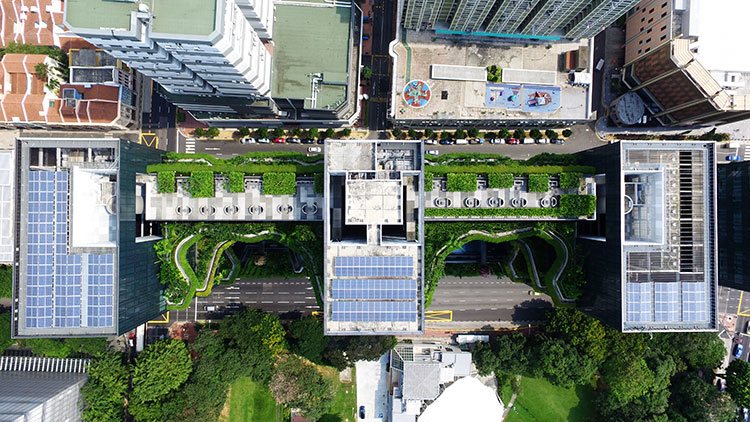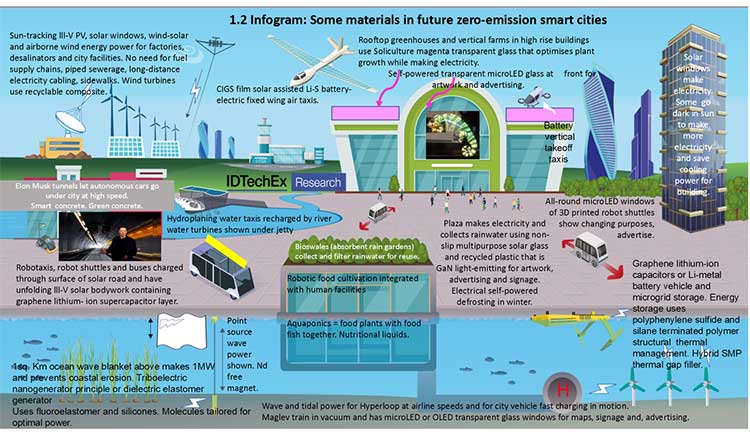![]()
Modern building with solar-cell facade for energy harvesting. [Image: Getty Images]
The dreams being spun around “smart cities” of the future typically involve artificial intelligence, computing power and big data. In these visions, futurists point to the prospect of vast networks of sensors feeding information into digital systems that adjust traffic and transit patterns, allocate energy use, and tune a raft of other urban parameters.
But the technology market research firm IDTechEx believes that another enormous research and business opportunity is hiding in plain sight in these emerging smart cities: The advanced (and, sometimes, not-so-advanced) materials that will be used to create them.
“The people who do conferences on smart cities are too obsessed with information and communications technology,” says Peter Harrop, the company’s chairman and the lead author of the new study, “Smart Cities Emerging Materials Market 2021–2024.” The I.T. dimension is important, he says—but much of the heavy lifting that will be done to make cities smart, particularly in the realm of energy, water management and similar areas, is “done with hardware, not software.”
This materials dimension of smart-city development could, according to the IDTechEx study, spawn a market as great as US$400 billion. And many of the technologies animating this vision—such as cutting-edge photovolatics, solar pavements and materials for next-generation displays and smart windows—are optoelectronic to the core.
Big-ticket city projects
The frothy prospects envisioned for smart-city technology markets, including advanced materials, lie partly in a number of high-profile megacity projects now on the drawing boards.
One of those, NEOM—a portmanteau of the Greek neo (new) and the Arabic mostaqbal (future)—aims to carve a vast, renewable-energy, IT-powered smart environment out of a 26,500-km2 corner of the Saudi Arabian desert. Another, Forest City in Malaysia, would reclaim the territory for its smart urban center from four linked islands in the Malaysian Sea, against a backdrop of rising sea levels attributable to climate change.
These visions are still far from being realized. (The British magazine The Economist recently sniffed that for NEOM in particular, “little of [the project] has advanced beyond PowerPoint slides.”) Yet the nominal price tags of these next-gen urban behemoths, and the powerful investor groups behind them, point to significant market potential; the NEOM project will reportedly cost US$0.5 trillion to execute, and Forest City has a stated cost of US$0.1 trillion. “These are eye-watering sums of money,” says Harrop of IDTechEx.
Meanwhile, Harrop adds, it’s “not just new cities.” Existing municipalities are investing in niche areas of smart-city technology to solve specific problems. For example, according to Harrop, New York “is spending serious money going green,” and working on creative approaches, such as turbines in the East River, to pull clean energy from the environment. “They’re entitled to call themselves a ‘smart city’ in that aspect.”
An information graphic from the IDTechEx report offers a glimpse at the wide array of materials technologies that could be affected by the smart-city market. [Image: Courtesy of IDTechEx] [Enlarge image]
“Solar everywhere is a given”
For the materials side, and materials tied to optoelectronics in particular, smart-city market growth will come, in the view of IDTechEx, from the need for cities to become increasingly self-sufficient in the production of food, water and clean energy—in ways that move toward a zero-emission framework. Advanced materials, the report concludes, could consume some 25% of the total spending toward that “heroic” objective. And increasingly, those materials will be ones that handle multiple tasks—self-healing roadways that also produce solar energy, for example. “ ‘Multipurpose’ is a buzzword that runs through all of this,” says Harrop.
The study envisions next-gen buildings taking advantage of a variety of technologies, either developed or in development. Examples include thin photovoltaic films or even photovoltaic paints installed as cladding on new buildings, and dramatically increased use of “smart windows” that can both selectively darken to manage diurnal heating/cooling requirements and generate solar electricity.
“Solar everywhere is a given,” says Harrop—“solar roads, solar pavement, solar fences, solar windows, solar building facades, solar building roofs, solar vehicles that never plug in … Making energy is really the easiest thing for a city to do.” IDTechEx envisions a US$35 billion market for emerging non-silicon-based materials to provide such “ubiquitous photovoltaic power.”

Aerial drone photo of hanging roof gardens and rooftop solar installation at Park Royal Hotel, Singapore. [Image: Getty Images]
Other dimensions
Another side of the smart-city materials market will come, according to the IDTechEx study, from climate change’s baleful impacts on global sea level. “We’re going to have to learn to live with water,” Harrop maintains. “We’re going to make electricity from water, travel through water, travel on water, grow food in water … Water management is a very, very big thing.”
That puts a premium, according to the study, on “water-centric” materials—some yet to be developed—such as desalination membranes, materials involved with sewage treatment, and others. It will also push cities increasingly toward mixed renewable-power schemes combining wind, solar, and energy harvested from ocean wave and tidal power. “If you mix all of these up,” says Harrop, “you can balance the load that’s needed in the smart city virtually without energy storage.”
Still other materials opportunities, according to the research, sit in areas more conventionally associated with smart-city proposals. These include OLEDs, microLEDs and other display technologies for multifunction, multilayer displays aboard robotic shuttles, and composites and niche materials supporting sensor and lidar systems. Much of the progress in smart cities will also be driven, according to Harrop, by an ongoing theme of reducing or eliminating batteries whenever possible, through devices such as improved supercapacitors and new power-stingy technologies such as “6G” wireless.
“Lead paint through the back door”
To a large extent, of course, these trends flow from the need for cities to find ways to address their contribution to global climate change. To reduce “the 16% of global warming caused by making concrete and steel,” for instance, the report envisions the rise of multifunctional “green concrete,” which it tags as “one of the most impactful smart-city materials.”
Yet Harrop also raises a warning flag as cities rush toward experimenting with new technologies: the risk of inadequate attention to the toxic substances used in making many of them. He points, for instance, to the perovskite photovoltaic paints—many with lead as a key component—that are being explored for buildings. “That’s lead paint coming in through the back door,” he says. And other materials carry different risks in urban environments that, he believes, need to be carefully considered.
“My message for smart cities is that it would be wise to be more critical of poisons and toxins, both organic and inorganic,” and to think about disposal and fire risks, as well as safer alternative options, when considering potentially hazardous technologies. “There usually are alternatives; that’s the point.”
Not an optional shift
Harrop’s view, and that of the IDTechEx report, is that development of smart-city infrastructure such as they envision is inevitable, given long-term environmental trends. “Although smart cities can’t be precisely defined, we think there are certainly going to be trillions of dollars of investment per year,” Harrop says. “It’s not optional; you have to do something … And the optoelectronic angle is going to be very big.”
More on the IDTechEx report can be found at https://www.idtechex.com/en/research-report/smart-cities-emerging-materials-markets-2021-2041/792 .

